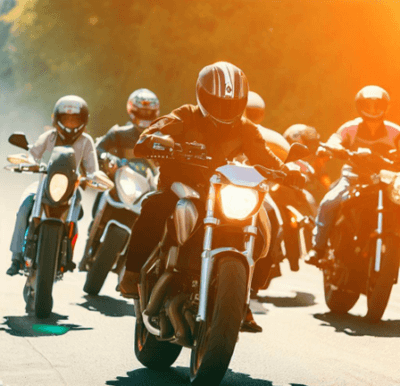How to Stay Safe on a Charity Motorcycle Ride
 Motorcycle group riding can be a fun and rewarding way to support a good cause, meet new friends and enjoy the open road. However, it also can pose some unique challenges and risks that riders need to be aware of and prepared for.
Motorcycle group riding can be a fun and rewarding way to support a good cause, meet new friends and enjoy the open road. However, it also can pose some unique challenges and risks that riders need to be aware of and prepared for.
Riding in a large, closely spaced group, especially on busy urban roads, can expose riders to hazards such as cars cutting in, road debris, chain-reaction crashes and rider fatigue.
Here are some tips on how to plan for and participate in a safe and enjoyable motorcycle charity ride:
Before the Ride
- Choose a reputable and well-organized charity ride that suits your riding style, skill level and interests. Check the route, distance, duration, pace and expected number of participants. Avoid rides that are too long, too fast, or too crowded for your comfort level.
- Make sure your motorcycle is in good working order and has enough fuel for the ride. Perform a pre-ride inspection and check the tire pressure, oil level, brakes, lights, horn and chain or belt tension. Carry a tool kit, a first-aid kit, and a cell phone in case of emergencies.
- Arrive on time at the designated meeting point and attend the riders’ meeting. This is where the organizers will discuss the route, rest and fuel stops, hand signals, riding formation and emergency procedures. Pay attention and ask questions if anything is unclear.
- Assign a lead rider and a sweep rider. The lead rider should be an experienced rider who knows the route well and can set a safe and steady pace for the group. The sweep rider should be another experienced rider who stays at the back of the group and monitors the riders’ condition and behavior. The sweep rider should also carry a first-aid kit and tools, and have the contact information of the organizers and the lead rider.
- Keep the group size manageable. Ideally, a single group should consist of five to seven riders. If there are more riders, split them into smaller sub-groups with their own lead and sweep riders. Leave a few seconds gap between each sub-group to allow other vehicles to pass safely.
During the Ride
- Ride in a staggered formation. This means that the lead rider rides in the left third of the lane, while the next rider stays at least one second behind in the right third of the lane; the rest of the group follows the same pattern. This allows each rider to have a clear view ahead and enough space to maneuver and react to hazards. Maintain a two-second gap between you and the rider directly in front of you.
- Use hand signals to communicate with other riders. Hand signals are a simple and effective way to convey information, such as turning, stopping, slowing down, speeding up, hazards, fuel level, etc. Learn the common hand signals (see table below) and use them consistently throughout the ride.
| Signal | Meaning |
| Left arm straight out | Left turn |
| Left arm bent 90 degrees upward | Right turn |
| Left arm extended straight down | Stop |
| Left arm bent 90 degrees downward | Slow down |
| Left arm raised up and down | Speed up |
| Left arm pointing to left side of bike | Single file |
| Left arm pointing to right side of bike | Staggered formation |
| Left arm waving over head | Pull off |
| Left hand tapping top of helmet | Police ahead |
| Pointing at road surface with finger or foot | Road hazard |
- Know how to pass cars as a group. Passing cars can be tricky when riding in a group, especially on busy roads. The lead rider should watch for a large enough space for the whole group to move over safely. If that’s not possible, each rider should make individual lane changes as soon as possible, returning to their original positions within the new lane. Maintain your speed when changing lanes, and do not cut off other vehicles.
- Ride in single file when necessary. There are situations where riding in a staggered formation is not advisable or possible, such as on curvy roads, poor visibility or road conditions, entering or leaving highways or other situations where more space or maneuvering room is needed. In these cases, switch to a single file formation with a minimum two-second following distance between each rider.
 Periodically check on other riders using your mirrors. If you see a rider falling behind or having trouble keeping up with the group, slow down so they can catch up. If all riders follow this procedure, the group should be able to maintain a fairly steady speed without pressure to ride too fast or too slow.
Periodically check on other riders using your mirrors. If you see a rider falling behind or having trouble keeping up with the group, slow down so they can catch up. If all riders follow this procedure, the group should be able to maintain a fairly steady speed without pressure to ride too fast or too slow.- Don’t ride beyond your skills or comfort level. Riding in a group can sometimes create a false sense of security or peer pressure to keep up with others. However, you should always ride within your own abilities and limits, and respect the abilities and limits of other riders. If you feel uncomfortable or unsafe at any point, signal to the sweep rider and pull over at the next safe spot. You can always rejoin the group later or take a different route.
After the Ride
- Thank the organizers and other riders for a great ride. Express your appreciation and feedback to the people who planned and hosted the charity ride. Share your experiences and stories with other riders and celebrate your achievements. You might also want to exchange contact information with some of the riders you met and enjoyed riding with.
- Donate to the cause. If you haven’t already done so, make a donation to the charity that the ride was supporting. You also can spread the word about the cause and the ride to your friends, family and social media followers. You might inspire others to join you on the next ride or support the cause in other ways.
- Reflect on your ride and learn from it. Riding in a group can be a valuable learning opportunity for any rider, regardless of their skill level. Think about what you did well and what you could improve on. Identify any areas where you need more practice or training. Review any incidents or near-misses that occurred and how they could have been prevented or handled better.
Riding in a group can be a rewarding way to enjoy motorcycling and support a good cause, but it requires some planning, preparation and communication. By following this advice, you can ensure a safe and fun group ride for yourself and others.
We at the Herd Law Firm, PLLC, are drivers and motorcycle riders, too! We support drivers, bikers and motorcyclists injured on the road, and have successfully represented such victims seeking the assistance and compensation they so need and deserve.
6/16/2023
Sources
- Charity ride crashes show why vigilance is always needed – RevZilla
- 7 Safety Tips for Motorcycle Group Riding – Nationwide
- QUICK TIPS: MSF’s Guide to Group Riding – Motorcycle
- Group Riding Best Practices | Rider Magazine
- Motorcycle Group Riding Safety Tips – Motorcycle Lawyer LA
- Motorcycle Group Riding Safety | DMV.ORG







